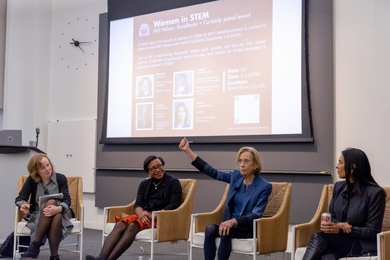The genetic blueprint for a human being consisting of a draft sequence and initial analysis of the human genome will be published in the February 15 issue of Nature.
The map, which is more than 95 percent complete and covers 96 percent of the genome, was a collaborative effort. The Human Genome Project (HGP) international consortium is made up of scientists from 20 institutions around the globe. MIT biology professor Eric Lander is director of the Whitehead-MIT Center for Genome Research, one of the five largest institutions in the public consortium.
This draft sequence represents scientists' first global view of the human genomic landscape, which provides a wealth of information about human development, physiology, medicine and evolution. A Phase One "working draft" of the genome was begun in March 1999 and completed last spring.
"We are standing at an extraordinary moment in scientific history," Professor Lander said. "For many years to come, we will be exploring the intricate details of the terrain ahead. We've got a long way to go before we will ultimately understand all the secrets the genome has to tell us."
Among the results:
- Scientists now estimate that humans have some 30,000-35,000 genes, only about twice as many as the worm or the fly. Humans are apparently able to do more with single genes than other species, producing on average three different proteins per gene.
- Scientists found that the ratio of mutations in the X and Y chromosomes and in the male vs. female germ lines is 2:1. The higher mutation rate in the male germ line may be due to the greater number of cell divisions involved in the formation of sperm.
- We have a greater percentage of junk DNA -- characterized by long stretches of repeating sequences -- in our genomes (50 percent) than the mustard weed (11 percent), the worm (7 percent) or the fly (3 percent).
In a related announcement, the biotech firm Celera Genomics announced that it had published its human genome sequence in the journal Science. The company used a combination of its own data and the consortium's data, available freely on line at sites including http://www.ncbi.nlm.nih.gov/Genbank/.
While the draft genome sequence has provided an initial look at the human gene content, many ambiguities remain. One of the HGP's priorities will be to refine the data to accurately reflect every gene and every alternatively spliced form.
View the video of Eric Lander's 2/16/01 lecture on the Human Genome Project:
A version of this article appeared in MIT Tech Talk on February 14, 2001.





